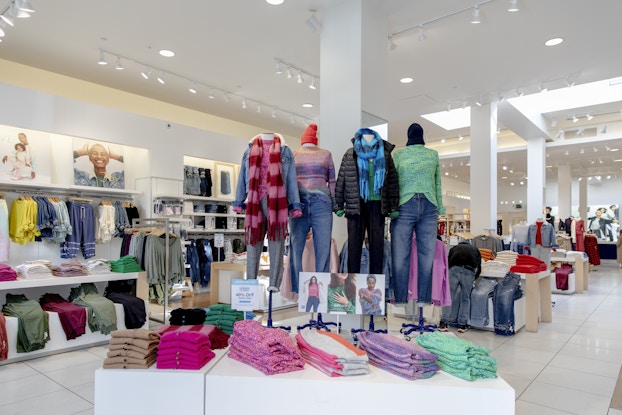
Key Takeaways:
- The pandemic accelerated consumer adoption of tech-fueled lifestyle conveniences.
- Crisis stokes a growing self-care market that’s seen businesses from therapy apps to eyelash extension salons flourish.
- The work-from-home fueled ‘casualization trend’ that spiked in 2020 is poised to be a dominant force across fashion categories in 2021.
Google, Gap and men’s grooming disruptor Bevel are betting on self-care, comfort fare — think cashmere joggers — and digital, touch-free shopping conveniences to woo pandemic-battered consumers and drive retail sales in 2021, executives from the tech giant, legacy apparel chain and Procter & Gamble’s DTC startup told CO—.
The trio of brands reflect disparate facets of the retail sector, yet their growth outlooks, informed in part by what drove holiday sales, echo the COVID-nudged trends reshaping the consumer economy today.
And those trends mirror the times. The pandemic has hastened consumer adoption of tech-fueled lifestyle conveniences, and for today’s Zoom-meeting, DoorDash-dining, Peloton-peddling consumers, there’s seemingly no turning back, executives said.
The crisis has also stoked a growing self-care market that’s seen businesses from therapy apps to eyelash extension salons flourish, just as the work-from-home boom alters the trajectory of fashion long-term.

Gap: ‘We will continue to capitalize on the casualization of fashion’
The pandemic dealt a harsh blow to the fashion industry, shuttering non-essential retailers like Gap for months, just as the pivot to remote work rendered the notion of dressing for the office virtually obsolete.
“The casualization trend that was already in motion before the pandemic and that accelerated throughout 2020 is likely to emerge as a dominant force across many fashion categories in 2021,” according to a McKinsey report on the state of fashion this year.
Gap is counting on that outlook to buoy its sales revival plan. As the apparel chain shutters underperforming stores and pivots from struggling enclosed malls to freestanding locations, it’s also recommitting to the casual fare that burnished its status as America’s go-to leisurewear in the ‘70s, to boost business today.
“Our customer is voting for comfort while they stay at home. Categories that Gap has always stood for — joggers, fleece and active have been the winners over the past few months and will continue to be some of our core offerings,” Chris Goble, chief product officer and general manager for Gap, told CO—. “Our core casual categories have made a huge comeback in the last few years, especially now when we are all craving comfort,” he said.
But consumers won’t want to don loungewear alone forever, said Jane Hali, CEO of investment research firm Jane Hali & Associates. “We do believe casualization will continue in 2021, but with the vaccine we will also see pent up demand on occasion and dressing up,” she said, warning that Gap is “behind the curve.”
Goble contends that the chain as well positioned. “Going into 2021, Gap is in a sweet spot,” he said. “We will continue to capitalize on the casualization of fashion as a long-term industry trend and provide what customers want – casual elevated essentials, activewear, denim and fleece.”
Shoppers were gravitating to on-demand perks like buy online, pick up in store (BOPIS) and curbside pickup pre-pandemic. Now these features have advanced from a mere convenience to a health and safety imperative, which isn’t lost on Gap.
To ensure its shopping experience is as “safe and efficient as possible, we’ve invested in our online and in-store experiences, including BOPIS and curbside pickup,” Gobel said. “We see these investments growing in the long term — currently, the success behind these new customer experiences has allowed us to be there for our guests when they want it and how they want it.”
Indeed, consumers rank the ability to complete store transactions in a New York minute as a must-have shopping feature, according to Zebra Technologies shopper study. The survey found that 76% of consumers, concerned over exposure to other shoppers, are eager to get in and out of a store as quickly as possible.

Google: ‘Home becomes the new shopping environment’
Sheltering-in-place orders forced consumers to navigate their lives in unprecedented ways, tapping digital ecosystems to work, learn, exercise and shop from their living rooms and kitchen tables — habits that look to stick post-crisis, sources said.
“During COVID, we’ve seen unprecedented digital adoption. People are getting used to being virtually connected to their doctors, attending classes, working out on home gym equipment with virtual trainers and working from home while collaborating with others,” according to the Visions into the Future report from global retail consultancy Traub. “Customers have gotten used to the habit of convenience and they will continue to demand it.”
Google is betting that consumers’ homes will remain ground zero for their shopping transactions, with mobile apps gaining heightened importance as a touch-free convenience tool amid the COVID-fueled e-commerce boom.
Shopping is undergoing a fundamental shift where we’re seeing a dramatic acceleration towards e-commerce.Jodi Goldberg, head of industry, apps and e-commerce, Google
“Shopping is undergoing a fundamental shift where we’re seeing a dramatic acceleration towards e-commerce,” Jodi Goldberg, head of industry, apps and e-commerce for Google, told CO—.
Indeed, 73% of app users who buy in-store at big box retailers say shopping will change due to COVID-19, she said, citing Google figures. “This makes sense because 64% of app users are realizing they can get a lot of everyday tasks done when they are at home. As home becomes the new shopping environment, it's critical for brands and retailers to think about their digital shopping experience, as consumers shop straight from their living room,” she said.
“We also see many consumers starting their purchase journey online and completing it in the physical world,” Goldberg said. “Businesses should be responsive to those preferences by making sure they’re present online with their full catalog of products and then providing these newer fulfillment options.”
For its part, Google is angling to help retailers and brands bridge the offline and online world by shepherding shoppers from inspiration and discovery to purchase. Its Google Shopping feature, for example, surfaces information from thousands of local stores in one place, enabling consumers to compare millions of products, prices and places to buy from a store nearby or online.

Black men’s grooming brand Bevel: Creating products for underserved consumers
After food and beverages, health, personal care and beauty emerged as the second fastest-growing categories online in 2020, as more shoppers tapped e-commerce for consumer staples amid the pandemic, according to eMarketer data. The categories reached an estimated $72.1 billion in U.S. sales in 2020, surging 32.4% from 2019.
That comes as direct-to-consumer men’s brands from Dollar Shave Club to Harry’s steadily change the complexion of the personal care aisle, “disrupting incumbent brands’ dominance on physical store shelves,” said Andrew Lipsman, a principal analyst for eMarketer, in its e-commerce report on how the pandemic is reshaping the product category landscape.
DTC startup Bevel, which launched as a shaving brand and has added skincare, body care and hair care, ranks among them, available in some 10,000 retail doors from Target to CVS. Now backed by Procter & Gamble, which snatched up the brand when it acquired parent firm Walker & Company in 2018, the men’s grooming disruptor aims to corner the long-underserved market of personal care for African American men.
“From a general standpoint, we’ve seen a strong increase in e-commerce as consumers turned online more and more during the pandemic,” Tia Cummings, vice president of marketing for Walker & Company, told CO—. “So, we’ve made efforts to improve our online shopping experience. I don’t think that is unique to us.”
More pointedly, it’s the socioeconomic blows Bevel’s consumer base absorbed in 2020 that’s informing its 2021 strategy, she said.
That’s why this year, Bevel is tightening its embrace of Black men who’ve weathered a year singed by both racial injustice and financial hardship, by offering more product value, as well as self-care for the body and soul, like “master classes’ on grooming tips and trends and videos that celebrate the stories of African American men — from a professor to an artist to a runner.
Bevel’s stated mission to “remind the world that Black men need self-care too,” comes to life in its Created for Kings push. “A love letter to Black men” that launched during the holiday, the campaign’s message will remain front and center for Bevel in 2021, Cummings said.
“Our marketing approach at holiday was really driven by what we observed throughout the year; 2020 [had] been a tough year for many, but especially for the Black community and Black men in particular. They were hit hardest by the pandemic, physically and economically. And the continued fight for racial justice has been exhausting. So, it was important for us to show our consumers that we understood what they were going through and we're here to support them.”
Created for Kings aims to “remind Black men of their greatness and encourages others to do the same,” she said. “We’ve seen a tremendous positive response to this message as people told us it was sorely needed.” [For more on Bevel, read CO—'s feature here.]
Bevel has also placed a heightened focus on amping up the savings value of its product offerings by launching more shaving, skincare, hair care and body care bundles that allow consumers to purchase more for less, while stoking innovation to develop more features-and-benefits-rich products that “help consumers save money without sacrificing quality,” Cummings said. “That’s important in a year where so many have been impacted financially.”
It’s what broad swaths of U.S. shoppers have come to expect, as the socioeconomic fallout from the pandemic is poised to weigh heavily on consumers’ spending decisions this year, Nielsen predicts.
“In 2021, constrained spenders will continue seeking out cheaper alternatives to the product options they would normally buy, opting for more value offerings and private label products, at least for their everyday staples,” according to Nielsen. “Tiering products and pricing will become increasingly important as the year progresses.”
CO— aims to bring you inspiration from leading respected experts. However, before making any business decision, you should consult a professional who can advise you based on your individual situation.
Follow us on Instagram for more expert tips & business owners stories.
CO—is committed to helping you start, run and grow your small business. Learn more about the benefits of small business membership in the U.S. Chamber of Commerce, here.






